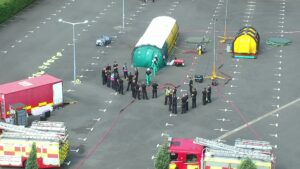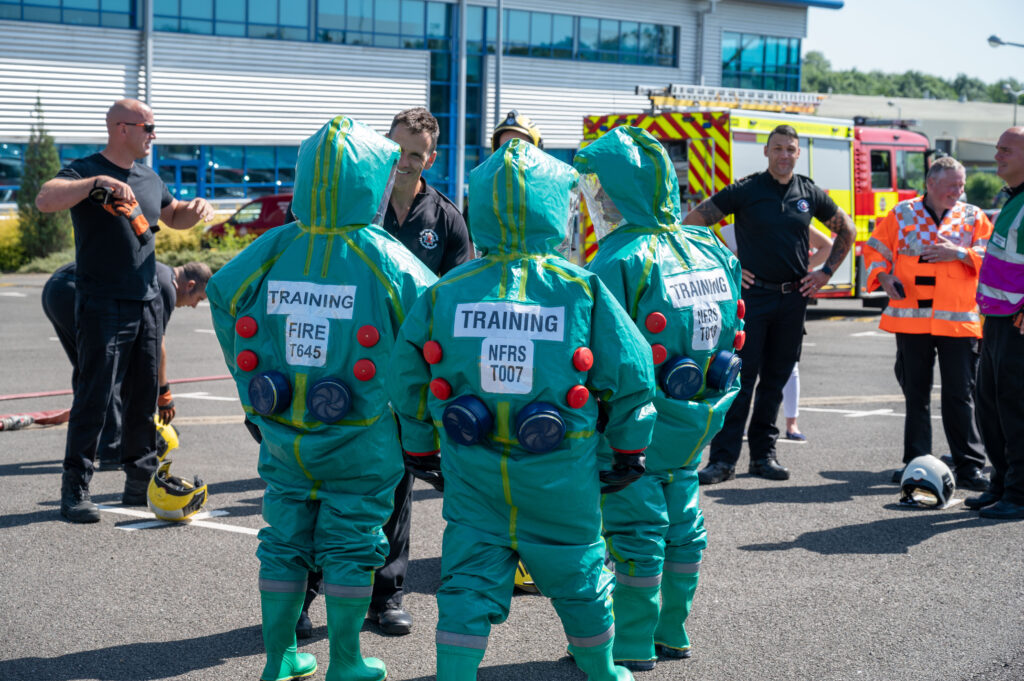Every year, firefighters undergo various training exercises to assess their capability at incidents and to revalidate key operational skills, not just in attending fires, but also road traffic collisions, water rescues and flooding, as well as incidents involving hazardous material.
Over the summer months crews from Northamptonshire Fire and Rescue Service (NFRS) have been running exercises to ensure that they are meeting the national standards for responding to large-scale incidents involving chemical or hazardous material.
 The mass decontamination exercise involves following a structured procedure to set up the specialist equipment in order to effectively and simultaneously decontaminate potentially hundreds of people. Across the UK, there are just 28 mass decontamination units (MDU) one of which is within NFRS. In order to maintain capability and contribute to building resilience across the UK, the Service must not only run these exercises regularly, but guarantee a minimum of 24 specially trained firefighters are available on duty 24/7.
The mass decontamination exercise involves following a structured procedure to set up the specialist equipment in order to effectively and simultaneously decontaminate potentially hundreds of people. Across the UK, there are just 28 mass decontamination units (MDU) one of which is within NFRS. In order to maintain capability and contribute to building resilience across the UK, the Service must not only run these exercises regularly, but guarantee a minimum of 24 specially trained firefighters are available on duty 24/7.
National resilience guidelines stipulate that from the moment the fire service arrive on scene they are required to set up two decontamination units, one for crew and one for the public, and be ready to receive and treat casualties within 40 minutes, which the Service is comfortably achieving.
Crew working in the warm zone, where they are engaging with casualties and contaminants, wear specialist power respirator protective suits that provide them with up to one hour of protection from any hazardous material. These specialist firefighters will assist casualties to move through the MDU; disrobe and showering, and they will provide a clean re-robe pack to replace contaminated clothing.

As well as decontaminating the casualties, the fire service is required to consider the environmental impact of the incident and make provision to minimise the spread of the contaminant. All contaminated wastewater from the showers is channelled into a wastewater containment dam for testing and safe disposal.
The Service also has access to detection, identification and monitoring (DIM) equipment, which is particularly useful when the hazardous substance is not known. As well as identifying the substance, this equipment also supports the monitoring of contamination zones and spread, helps maintain the forensic integrity of the incident and informs incident commanders and other agencies when making critical decisions, especially whilst considering ways to minimise risk to emergency personnel, the public and the environment.

Area Commander at NFRS, Phil Pells said: “These Mass Decontamination exercises are critical in maintaining our operational response to high threat, high harm incidents. This specific capability enables the fire and rescue service with partner agencies to coordinate the removal of contaminants from large numbers of people in a mass exposure event.
“It’s essential our firefighters maintain their skills in the use of this equipment and future exercises will involve other Fire and Rescue Services, the Police and Ambulance Service responders.”









